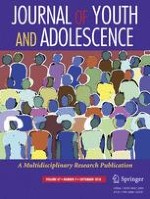13-03-2018 | Empirical Research
How do Adolescents Learn Cyber-victimization Coping Skills? An Examination of Parent and Peer Coping Socialization
Gepubliceerd in: Journal of Youth and Adolescence | Uitgave 9/2018
Log in om toegang te krijgenAbstract
Recently, cyber-victimization has become an ever increasing concern for adolescents. Given the negative consequences of cyber-victimization, it is important to understand how adolescents learn strategies to cope (i.e., “coping socialization”) with cyber-victimization. The purpose of this study is to understand common coping strategies reported by adolescents, identify from whom youth learn cyber-victimization coping strategies (coaching), and explore how coaching is associated with adolescents’ self-reported use of coping. In a sample of 329 adolescents (49% male; 70% white), we found that positive coping strategies (e.g., problem solving, seeking social support) are used most frequently, and adolescents’ perceptions of both parent and peer coping socialization is associated with self-reported use of coping. Interventionists can use this information to adapt interventions to include influential positive socializers.
